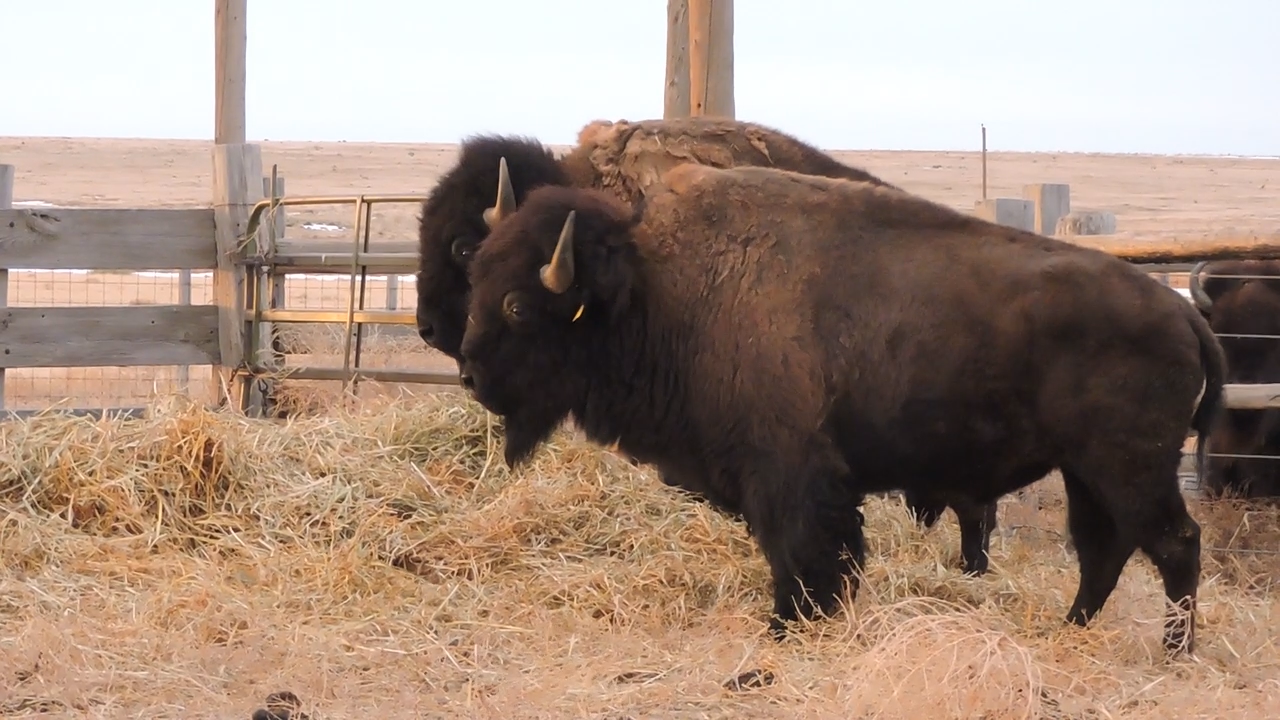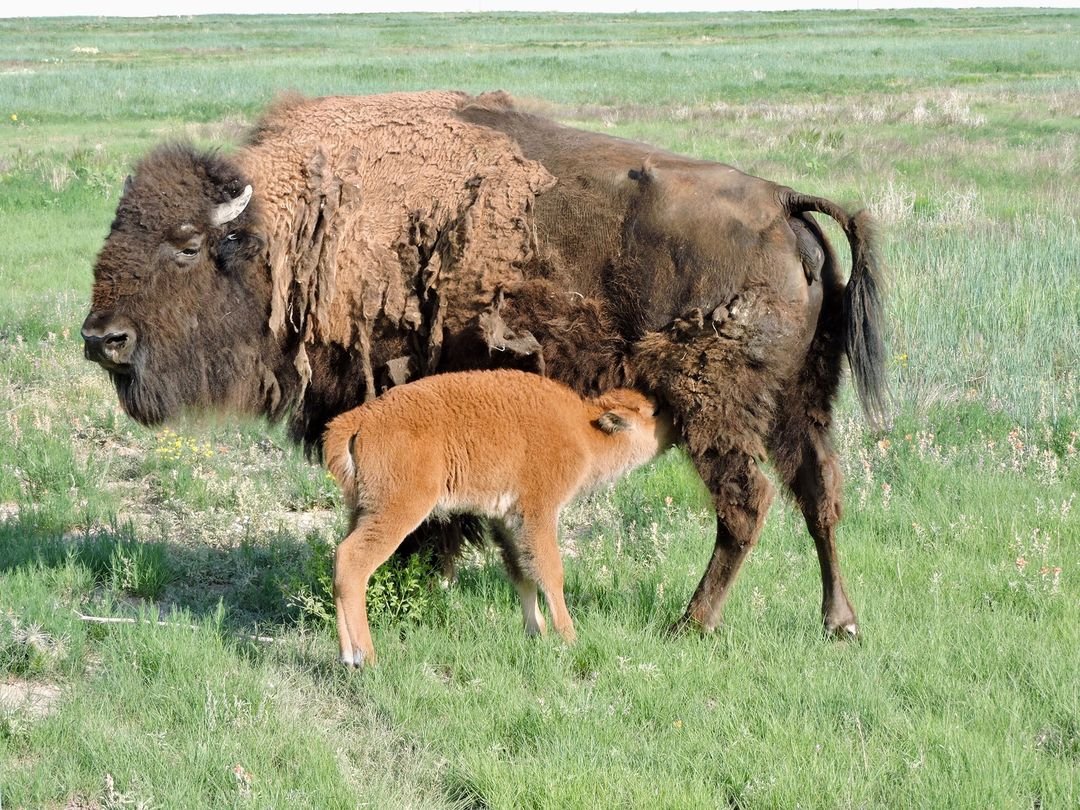Torrey Davis, Southern Plains Land Trust
So why do we have two different Bison bison bison herds?
In December of 2020, the Southern Plains Land Trust began a brand-new conservation bison herd with ten American plains bison (hence Bison bison bison) on the shortgrass prairie of southeastern Colorado. This opportunity was made possible through a partnership with Colorado State University (CSU) and additional support from Defenders of Wildlife. We also added another ten bison that went to our sanctuary herd. Now, you may be wondering, why do we have two separate herds? Why not keep them together? To answer that question, we must go back in time to fully understand the complexity of the answer.
Long before European settlers first set foot on the North American continent, bison roamed from Alaska to Mexico and from Virginia to California. Some estimates report that their total population was between 30 and 60 million animals. The word for bison in Salish, today an endangered Native American language, is “Quee-quai,” which literally translates to “many little black spots.” That should give you an idea of how abundant these animals were. Bison were extremely well adapted to their home on the plains, and their numbers flourished for generations.
Tragically, after European settlers arrived, bison populations were severely reduced through extreme overhunting, disease, and habitat loss. By the 1870s to 1880s, their numbers were at just a few thousand animals. This catastrophic event in biological terms is known as a bottleneck – a dramatic decrease in a population’s number. These events are usually caused by a sudden environmental disaster, but in this case the bottleneck was caused by direct human interference.
Take a moment to think about that. From literally being defined as “many little black spots,” to being reduced to only a few handfuls of animals. What saved these scattered groups of bison were conservationists, ranchers, Native Americans, zoos, and the pure chance of being in an isolated spot that hunters could not reach. For example, in 1879 a prominent rancher in the southern plains, Charles Goodnight, captured and protected several bison calves. Goodnight’s intent was to preserve the animals and propagate them for the future. The ranchers were not entirely without an ulterior motive, however, and many of them practiced inter-breeding cattle with bison. They believed that the new “cattalo” hybrid animals would be hardier in the Great Plains environment, have better meat quality, and be better at foraging on the plains. These crossings usually occurred by breeding a male bison with a female bovine cow (Bos taurus). The viable offspring were usually female, as the male offspring were often sterile, if they survived at all.
Over time, these female hybrid offspring were crossed back with male bison or domestic bulls. The females and their offspring were again crossed in all possible combinations over multiple generations. This repeated interbreeding led to a genetic phenomenon known as introgression, where an animal may look and act like a bison on the outside, but on a genetic level, it contains some cattle genes mixed with its bison genes. Cattle genes often show up as “markers” when genetic tests on bison are done. A way you can think about this is like reading the grammatically correct sentence of a genetically pure bison. It would read as follows, with each word representing a gene: “Buffalo buffalo Buffalo buffalo buffalo buffalo Buffalo buffalo.” Whereas a bison with cattle gene introgression could genetically read like this: “Buffalo cattle Buffalo buffalo buffalo buffalo Buffalo buffalo.” See the difference?
Introgression isn’t the only part of the story, though. Today, after dwindling down to about 1,000 animals, bison numbers have grown to about 400,000 to 430,000 animals in North America. Of these, about 400,000 of them are managed as livestock for meat production. The remaining 20,000 to 30,000 are managed as wildlife. That leads to the importance of our new herd being managed as a conservation herd. This means that they will be managed as wildlife. They will serve their previous ecological roles, and not be used for commercial production. The conservation herd will essentially be allowed to live their lives as wild animals. They will aerate the earth with their hooves, fight for the right to mate, move plant seeds around, and dig big, dusty pits when they wallow.
And how is the conservation herd different than our sanctuary herd? The answer goes back to genetics. Our ten new bison are cattle-gene free and will be allowed to breed and grow in number, whereas our sanctuary herd has evidence of cattle-genes and are sterile. The sanctuary herd will of course still be able to live their natural, bison lives at the center of Heartland Ranch Nature Preserve. Having pure genetics is important because bison with cattle ancestry are considered hybrid animals. As hybrids they are not protected under policies such as the Endangered Species Act. Additionally, agencies such as the National Park Service support minimizing cattle gene introgression in bison and discuss it further in their 2010 Bison Conservation Initiative.
Today, there are about 60 conservation herds across the U.S. and Canada, with most of these herds containing hundreds to thousands of animals. Defenders of Wildlife, one of our key partners in establishing the conservation herd, has been a strong advocate for establishing new conservation herds across the species’ historical range. While bison are not freely roaming the plains as they once were, Defenders and other conservation groups are now thinking about these herds together as one large metapopulation. As our own conservation herd grows, we will eventually be able to trade with or donate animals with other conservation herds. This will help maintain the overall genetic diversity of the herds, while minimizing the spread of cattle genes. It’s a pretty amazing story that bison nearly went extinct, but now, with your support of the Southern Plains Land Trust, these animals are making a comeback to their rightful place on the plains.














